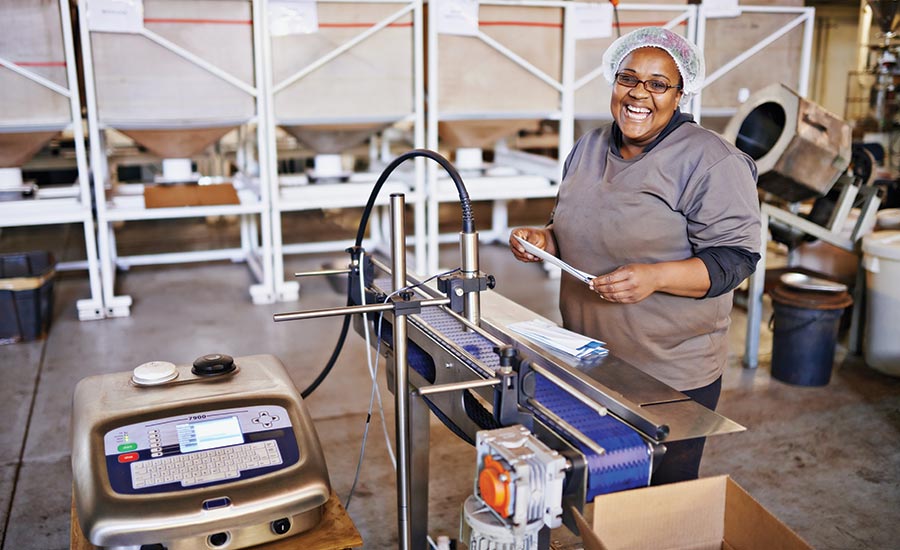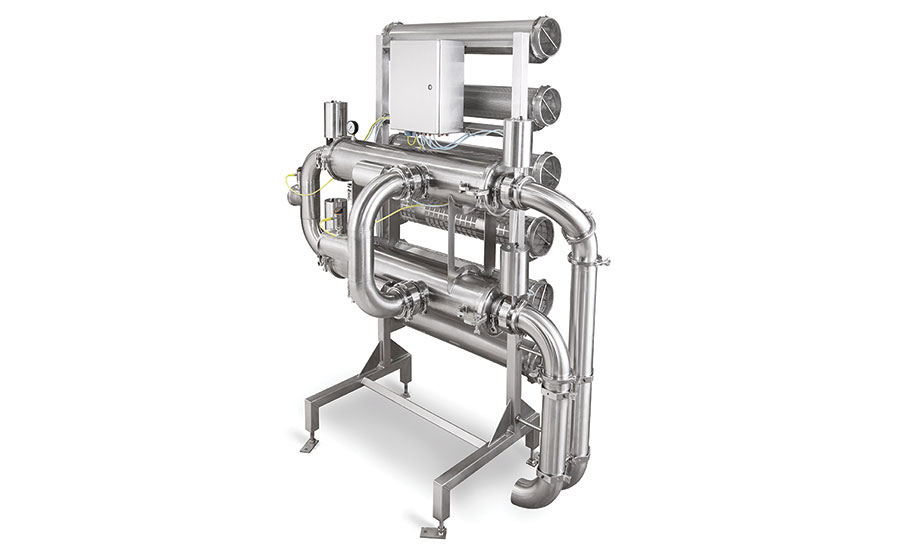Workforce
Worker shortage has processors scrambling to hire and keep good employees

With manufacturing short 2 million workers over 10 years, food and beverage processors are forced to rethink wages and recruiting practices, and try new ways to win employees’ loyalty.
Photo courtesy of Getty Images

Making a game out of policy initiatives is one way companies are trying to make work more pleasant for employees so they want to help the company succeed. Here Borden employees are learning about the Borden Difference, the dairy’s identity statement.
Photo courtesy of Borden

A Borden employee wins a vacation at the Elsie Awards, recognizing top performance by plants and individuals.
Photo courtesy of Borden

Helping with worker shortages: The Lyco Sanitary Zero-Maintenance screen was designed at the request of two big customers that had trouble finding people to clean them, says Jeff Zittel, vice president of technology. The CIP rotary drum floats in an oiled bed, eliminating daily lubrication of bearings. It can be enhanced with an advanced filtering system that removes more solids from screened water, making it clean enough to use a second time. Filters can be changed quickly.
Photo courtesy of Lyco

Helping with worker shortages: The Lyco Sanitary Zero-Maintenance screen was designed at the request of two big customers that had trouble finding people to clean them, says Jeff Zittel, vice president of technology. The CIP rotary drum floats in an oiled bed, eliminating daily lubrication of bearings. It can be enhanced with an advanced filtering system that removes more solids from screened water, making it clean enough to use a second time. Filters can be changed quickly.
Photo courtesy of Lyco





Borden CEO Tony Sarsam has made it a priority to hire the right people for the dairy’s force of truck drivers and gain their loyalty as frontline ambassadors for Elsie’s milk.
His salesforce members who drive the trucks to the stores, talk with Borden’s customers, write the orders and merchandise the products are the company’s largest employee group, and they are critically important to maintaining Borden’s mission to be the dairy with the best customer service.
Article Index:
A year into the job, Sarsam is trying to stem fairly substantial turnover in the group by offering the right pay for the workers’ markets, infusing the drivers with a sense of purpose to ensure their jobs are satisfying and soon offering candidates more help to start driving/sales careers. He makes a point to not think about drivers as simply people who drop off the product.
“If I think about them as a competitive weapon, then I might get a different performance,” he says.
Sarsam’s goals are shaped to Borden’s needs, but finding the best ways to hire and keep good people is an industrywide struggle. The list of pressures complicating hiring for food processors is long: a baby boomer retirement wave, lower interest in manufacturing jobs from younger generations, less emphasis on trade jobs as careers, a fairly strong economy that requires higher wages, and a population that’s not increasing at the rate needed to fill jobs and meet Americans’ expectations for business growth.
Plenty of statistics illustrate the lack of people to fill the jobs in the food and beverage industry and across the country. U.S. manufacturing is in the thick of an expected shortage of 2 million workers over 2015–2025, according to a report from Deloitte and the Manufacturing Institute. Talent is the top challenge among the evolving concerns of global executives, the 2017 report says.
“The real issue is that there are more jobs available today across all businesses in the United States than the entire sum total of everybody who’s looking for a job,” Sarsam says. “So this is a really interesting situation we have right now. It’s a lot of pressure on companies to figure out how to hire the right people.”
To help, he and others support greatly increasing the number of immigrants that the country accepts.
Bob Pudlock, president of Gulf Stream Search, which specializes in food, beverage and ingredient companies, says processors often turn to workers from other countries with visas to fill some of the most competitive jobs that require industry and/or technical expertise. The roles with the lowest worker supply and highest demand are in research and development, food safety, and food quality, he says.
With more requirements for safety and quality under FSMA, Pudlock has worked recently with more companies, including some that hadn’t used his search help before, that are desperate to fill jobs because they’re up against regulatory deadlines, he says.
The most competitive jobs with top wages winning desirable candidates are with companies creating products that are new and different, such as alternative proteins, and not with companies focused on offering variations of legacy products, he says.
For some jobs, such as plant managers, companies sometimes prioritize leadership over industry-specific skills. A hiring tactic that’s been successful for years in those cases is turning to the military to attract people as they finish their service and re-enter the civilian workforce, Pudlock says.
Barb Renner, Deloitte vice chairman and consumer products leader, says when she helps companies ensure that they’re training the right people for the future, the businesses sometimes project that they’ll have jobs requiring skills that don’t exist yet in the next generation of workers. “Talent is probably the top one or two issue of every company that I work with,” she says.
The recruiting models that companies used in the past might not work any longer, and they need to look to new schools for candidates in STEM fields or offer training to get strong candidates, she says.
Wages: Pay up for the best
Renner sees more companies getting creative to offer additional money or rewards for employees who help with goals important to the business, such as achieving efficiency measures, offering innovative solutions or “doing something above and beyond.” Executives should consider, “Is your compensation structure … really getting to what you’re trying to drive?” she says.
With raises, Sarsam says many companies fall into the trap of giving increases that are just big enough to avoid disruption from workers. To be able to offer competitive wages, Borden is evaluating pay and will invest more in positions and markets that have been undercompensated, and lower raises for people that have been overcompensated based on market rates.
His approach, carried throughout his various food industry jobs, is to be open with employees about what to expect for wages, including why they didn’t get as big of a raise one year. That way, the process of determining pay rates doesn’t seem mysterious.
Offering more aggressive salaries to new candidates gets better applicants who are more likely to help the company succeed, Sarsam says.
“Sometimes you’ll hear, ‘Well, money is not that important.’ Well, actually it’s plenty important. It’s just not the only thing. But I think it is the first thing in people’s minds: ‘What’s my potential to actually provide a stable living environment for my family if I come work here?’” he says.
In an industry that operates on such small margins and always tries to produce more with its resources, spending on competitive wages and improved employee experiences may seem counterintuitive, but it pays off, experts say.
With a focus on automation and increasing efficiency, “you need to have great people to do that,” Sarsam says.
He heard about a struggling company that cut its service awards and recognition program to save money. “I don’t think that’s a good way to go. I would suggest that if we found ourselves in trouble for whatever reason, the last thing I’m going to cut is something that will make people feel like they want to help me stay out of trouble.”
Culture: How to keep workers
Sarsam and the rest of Borden’s leadership team are trying a variety of ways to reduce the high turnover rate they inherited by showing employees that the executives will invest in the workforce and respect them with transparent communications.
“We still have a lot of work to really present this compelling offer to folks about a great place to work,” Sarsam says.
The company has a new newsletter, regular town hall talks, break room TV content, quarterly video updates from Sarsam and awards for people modeling five values that support Borden’s mission: service/heart, teamwork, creative problem solving, passion to win and having fun.
Executives visit a plant once a month or more because a connection with the leadership is important, he says.
People want to feel like they have a sense of purpose at work, and 15 to 20 years ago, companies focused more on promoting stability and opportunities for growth, Sarsam says. Today, believing in the company’s mission has taken on more importance.
Borden went through a lengthy exercise after Sarsam started, involving people from across the business, to develop an identity statement called the Borden Difference, which highlights signature strengths.
“We’re going to be the most service-oriented dairy. And through our people-first culture, we’re going to focus on providing our customers with great service to help them win, and we see a day when we will be the undisputed leader in the dairy industry because of that focus,” he says.
People feel connected when they like a company’s vision and understand what they need to do well in their jobs to help the business succeed. “Lack of that dialogue makes people just a cog in the wheel, and then people don’t like that, and they’ll leave to get a 10-cent-an-hour increase,” he says.
A key employee costs about $15,000 to hire, train and get past the early stages when they’re learning to run their part of the business, making some mistakes and figuring out how to be efficient, Sarsam says. “We spend a ton of money,” he says. “So if I cut down the number of those events I have, there’s a lot of money in that.”
Think long term
When search clients ask for Pudlock’s ideas about how to handle the shortage, he offers four ideas:
- Make products less labor intensive. Start with the mandate to make a product that requires less people to get it to the shelf and drive innovation back toward R&D.
- Invest in automation for areas with worker shortages.
- Start strategic recruiting partnerships. Team with the state to get immigrant-friendly policies and to recruit skilled talent to the region, not just the company. Work with universities and corporations to offer skill development and continuing education.
- Build a better case for immigrant recruitment. Companies should be open about their need for additional workers and offer data-backed justification for hiring immigrants.
A client of Pudlock’s with two plants outside Salt Lake City has trouble attracting people to the area for food scientist and quality and safety jobs. The company asked for his help after postings went unfilled for a long time. He advised them to go to high schools, the local trade school and Utah State University to form strong, action-oriented relationships and create long-term plans to prepare people to work there.
Eventually, maybe the company could get, say, 20 people in a graduating class who could take production line jobs. Perhaps three or four of those people will do a really good job, be detail oriented and want something more for their careers.
“These are your diamonds in the rough,” Pudlock says.
If those people don’t have the means for more education, he suggests that the company puts them in microbiology or chemistry courses to help them become the food safety technicians and supervisors.
“If you really want to solve this for your company, you’ve got to take a longer time horizon.”
If companies built up their farm systems, “I’d be out of business and hundreds of others like me. But it’s not the case,” he says.
Training and technology help
For years, companies have been taking on a larger role in educating and training people, even for entry-level jobs, as opposed to decades past when young people learned trade skills.
Borden is among the companies trying to offer strong candidates assistance, including specific instructions for immigrants new to the country and help for potential drivers to get their CDLs.
Offering on-the-job training helps reduce the stress some employees feel about rapidly evolving duties and new high-tech equipment, says Renner of Deloitte.
“You’re saying: I’m going to be adding capabilities and skills, so that gives them the confidence that they’re going to be ready to do the next role and keep moving within the organization.”
More companies are leveraging analytics to improve overall employee engagement, such as looking at vacation time, overtime hours and managers’ performance to anticipate when a worker might be frustrated or burnt out, Renner says. A manager could talk with the person about what he or she needs, or an article about work-life balance could be sent to the person through the company’s mobile phone engagement platform.
Mobile apps are helping companies connect with their workforces in all sorts of new ways, especially to help deskless workers, including drivers or sales staff, stay involved with what’s happening at the office or plant, according to Geraldine Osman, CMO of StaffConnect. The app is used by Sabra, the hummus and guacamole maker, and Yeo Valley, a large U.K.-based dairy provider.
From personal phones or other devices, on-the-go employees can access corporate intranets, electronic pay stubs and benefits information. “When they’re more connected, they’re typically more advocates of the company,” Osman says.
The app is generally well used by employees, who are encouraged in part by social features similar to a Facebook newsfeed where they can react to and share work-related content with colleagues, she says. If a person has an unsolved problem, he or she can quickly ask peers to help through a secure messaging feature.
The security aspects are a desired feature for companies that want to give workers a way to contact one another without using personal texting or messaging, where sensitive information could escape the organization.
Companies also use StaffConnect to provide employees:
- Onboarding information
- Rewards and recognitions, like a shout out for doing a good job
- Health and safety updates, latest policies
- Frequent “pulse” surveys to gather quick feedback and reactions, replacing long annual surveys on paper or by email
- Training videos, alerts to new content library additions
- Quizzes to ensure people saw policies or instructions
- Fun games or quizzes that help keep people interested in the app
With this increased engagement, companies are getting better at using their skill at cultivating loyal customers to improve employees’ experiences. “You have to come at it from the employee angle and get them engaged with the company to get them to want to be an advocate,” Osman says.
Companies are turning to this type of technology integration as they rethink how to create a digital workplace that matches how younger people are used to working, she says.
StaffConnect encourages companies to allow employees to communicate openly, rather than using the app for top-down information only. The platform becomes self-regulating because no posts are anonymous.
“It’s that kind of thing that gives the employees a voice and rewards them within the app, recognizes their feedback, incorporates their feedback into the whole loop of two-way communication,” Osman says.
Machinery, automation and productivity
The worker shortage makes increasing productivity more difficult, which leads to efforts to improve workers’ experiences to secure their help with growing the company, Sarsam says. “I can’t just put more people on the line or add more lines with the same number of people because I’m not going to be able to find them.”
Machinery advances that increase throughput help in the dairy industry, which he expects will slowly move away from its 1950s model of many small plants within a couple hours of consumers. In maybe 25 or even 50 years, dairy will follow the larger food and beverage industry to shift to fewer, bigger, more sophisticated plants that serve wider areas, he foresees.
Pudlock says while it’s true that automation cuts manual labor and results in higher-paying jobs for people to run the machines, those jobs have just as big of a shortage as the old jobs. “I find myself running in circles on this,” he says.
Renner points to an optimistic outlook in the 2017 Deloitte report about how manufacturers can dispel misperceptions about the industry. While Americans don’t have positive views about critical factors including pay, stability and benefits in manufacturing, they do understand that future jobs are likely to be high-skilled, cleaner, safer and more creative.
As companies leverage technology to reduce some repetitive, routine, possibly less safe work, people focus on “uniquely human” activities to make sense of analytics, communicate about them and fix problems, Renner says.
She gives the example of using sensors to monitor whether a machine is working properly instead of having someone possibly crawl under equipment to check out a problem. When a sensor helps anticipate a maintenance issue, skilled teams take care of the problem, and people collaborate on how to make the machine last longer or how to increase line capacity. Those types of jobs are the ones that will need filled.
Evolving equipment for labor shortages >>
For more information:
Borden, www.bordendairy.com
Deloitte, www.deloitte.com
Gulf Stream Search, www.gulfstreamsearch.com
StaffConnect, www.staffconnectapp.com
Looking for a reprint of this article?
From high-res PDFs to custom plaques, order your copy today!












